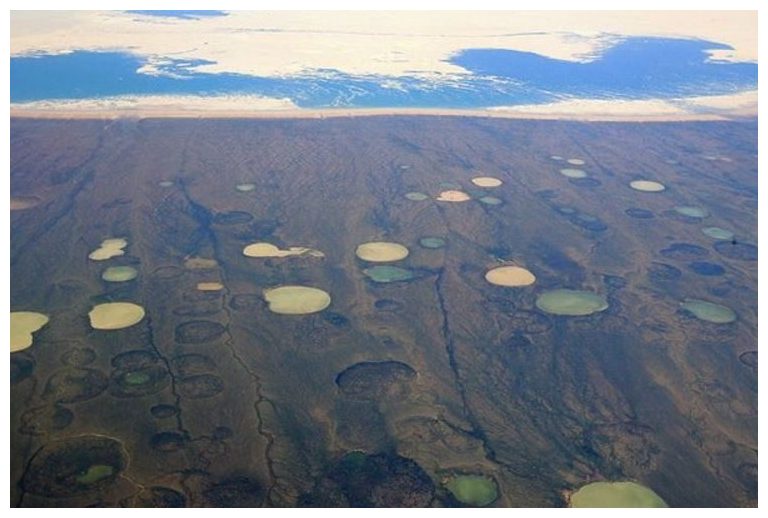
A research team made a worrisome discovery off the Siberian coast.
The scientists claim that frozen methane deposits in the Arctic Ocean have started to be released after determining that methane levels at the ocean’s surface were four to eight times higher than expected.
These high levels of the potent greenhouse gas have been detected down to a depth of 350 metres in the Laptev Sea near Russia.
The 60-member team on the Akademik Keldysh believe they are the first to observationally confirm the methane release is already under way across a wide area of the slope about 600km offshore. Really?
At six monitoring points over a slope area 150km in length and 10km wide, they saw clouds of bubbles released from sediment.
At one location on the Laptev Sea slope at a depth of about 300 metres they found methane concentrations of up to 1,600 nanomoles per litre, which is 400 times higher than would be expected if the sea and the atmosphere were in equilibrium.
Igor Semiletov, of the Russian Academy of Sciences, who is the chief scientist onboard, said the discharges were “significantly larger” than anything found before. “The discovery of actively releasing shelf slope hydrates is very important and unknown until now,” he said. “This is a new page. Potentially they can have serious climate consequences, but we need more study before we can confirm that.”
The most likely cause of the instability is an intrusion of warm Atlantic currents into the east Arctic.
For the second year in a row, this research team have found crater-like pockmarks in the shallower parts of the Laptev Sea and East Siberian Sea that are discharging bubble jets of methane, which is reaching the sea surface at levels tens to hundreds of times higher than normal.
This is similar to the craters and sinkholes reported from inland Siberian tundra earlier this autumn.
But while the discovery sounds alarming, it’s also been met with skepticism from some climate scientists.
This story is… unconvincing. First off it’s just two scientists (no publication), one of whom has made similar (unsupported) claims before & ignores the context that permafrost & methane have been degrading in this region since it was inundated in the early Holocene. https://t.co/EKI02cj2zT
— Gavin Schmidt (@ClimateOfGavin) October 27, 2020
There are climate feedback mechanisms to be worried about. A supposed "Arctic Methane Bomb" isn't one of them. https://t.co/yuOtqYUIKq
— Michael E. Mann (@MichaelEMann) October 27, 2020
Meanwhile, gigantic methane fields have been discovered around the world, i.e. along the Cascadia Subduction Zone in Washington and Oregon, off North Carolina’s coast, around Antarctica, near a giant submarine landslide in New Zealand, and in the German North Sea.
More Earth Changes news on The Guardian, The Week, Strange Sounds and Steve Quayle.












what about the super heated magma stream that appears under powerplants and high tension lines could there be a link between the 2 because once that stuff starts moving it only stops when its cooled off so this would tend to indicate this is now a global problem….what would happen if super heated magma stream contacted a large pocket or formation of large pockets of methane….fireworks on a grand scale
Michael Mann: another turd heard from – mr. fake data from East Anglia. Go back to sleep and let’s worry about cow farts….LOL
….most likely the cause of the Bermuda Triangle. No.. that was caused by the intersection of the magnetic fields/effects of 2 large Suns in the Milky Way Galaxy. On the opposite side of the Planet, in the Sea of Japan, there was a similar effect.. on time and space. The suns have now moved so these 2 locations no longer exist as such. Data from et in theyfly.com.
Its been said that uraniumhexafluoride has 24,000 times the greenhouse effect more than CO2
You missed the big one just off the coast of Florida most likely the cause of the Bermuda Triangle.
But the Global warming crowd has ignored it for many year because it does not fit the the narrative. After all it is in relatively warm climate and has the Gulf Stream above it.
But every year it releases more methane than the combined human world out put of CO2.
In the early 1990s I consulted a firm that was exploring potential market for hydroxylates in energy production. As the gas is biomethane it has an average energy of 5000BTU per cubic foot petro-methane is around 10,000BTU so it has a limit for market.
It can meet market if cracked into Hydrogen or reacted into Ammonia or Hydrazine but only at the ocean floor can you take advantage of the pressure present to over come conversion costs.
Still it provides more energy than wave or ocean current harvesting per dollar invested so perhaps in 6000years of so when we reach peek oil.
Very cool. Thanks for the info!